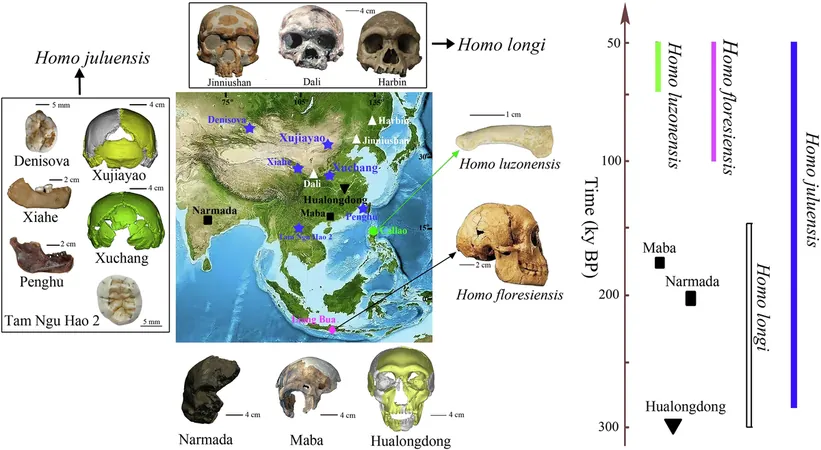
The Unveiling of Homo juluensis: What Ancient Big-Headed Humans Reveal About Our Evolution
2024-12-02
Author: Ming
Introduction
Researchers have made a groundbreaking discovery in the world of paleoanthropology with the identification of a new species called Homo juluensis, translated as "big head," after a remarkably large skull unearthed in China.
This discovery is not just another addition to the evolutionary family tree—it is a potential key to understanding the complex variations of ancient humans during the Middle Pleistocene epoch, which spans approximately 300,000 to 50,000 years ago.
The Study
The study, led by prominent anthropologists Christopher Bae from the University of Hawai'i at Mānoa and Xiujie Wu from the Chinese Academy of Sciences, seeks to clarify the murky waters concerning human evolution prior to the arrival of modern humans, Homo sapiens.
After our ancestors emerged around 300,000 years ago, they dispersed from Africa into Europe and Asia. Over decades, scientists have grappled with various fossils from archaic human predecessors like Homo heidelbergensis and Homo longi, often leading to contentious debates over species classification and meaningfully interpreting the evolutionary narrative—referred to informally as "the muddle in the Middle."
Recent Findings
In a pivotal 2023 paper published in The Innovation, Bae, Wu, and their colleagues argued that the use of broad terms like "archaic Homo" has complicated the understanding of evolutionary relationships.
They suggested that as fossil evidence accumulates, particularly in East Asia, clearer categorizations are necessary to accurately reflect the evolutionary framework.
Homo juluensis
The findings about Homo juluensis, documented in a May 2024 study in PaleoAnthropology, shed light on ancient hominin diversity.
Their examinations revealed fossils excavated decades earlier at Xujiayao in northern China, featuring an exceptional skull with both Neanderthal-like attributes and characteristics resembling modern humans and Denisovans.
The researchers contend that these fossils represent a previously unrecognized species from a widespread population in eastern Asia during the Late Quaternary period.
Fossil Discoveries
Fossils attributed to Homo juluensis date back between 220,000 and 100,000 years and come from significant archaeological sites such as Xujiayao and Xuchang.
Notably, more than 10,000 stone tools and 21 hominin fossil fragments were discovered at Xujiayao, indicating a robust presence of these large-brained hominins with thick skulls.
Meanwhile, the large skulls found at Xuchang showed distinct Neanderthal-like traits, reinforcing the complexity of human ancestry.
Implications for Human Evolution
Bae and Wu propose that the mixture of inherited traits found in these fossil groups suggests that Homo juluensis not only represents a new category of ancient humans but may also reflect hybridization among various hominin species during the Middle Pleistocene.
This process presumably influenced the evolutionary path of human development in eastern Asia.
Expert Opinions
Despite the novelty of Homo juluensis, acceptance among experts is gradually increasing.
Paleoanthropologist John Hawks noted the importance of naming in both evolutionary biology and anthropology, as categorizing these fossils benefits communication in understanding human history.
However, there remains skepticism regarding the classification, as some researchers, including Chris Stringer from the Natural History Museum in London, suggest that Homo juluensis may align more closely with Homo longi based on cranial characteristics.
Conclusion
As scientists continue to unearth and analyze more hominin fossils, the story of human evolution becomes ever more intricate.
The identification of Homo juluensis not only demonstrates the rich tapestry of our ancestry but also opens new conversations on how these different hominin species interacted, adapted, and ultimately shaped the history of human evolution.
As research unfolds, we may be closer than we think to revealing profound insights into who we are and where we come from.

 Brasil (PT)
Brasil (PT)
 Canada (EN)
Canada (EN)
 Chile (ES)
Chile (ES)
 Česko (CS)
Česko (CS)
 대한민국 (KO)
대한민국 (KO)
 España (ES)
España (ES)
 France (FR)
France (FR)
 Hong Kong (EN)
Hong Kong (EN)
 Italia (IT)
Italia (IT)
 日本 (JA)
日本 (JA)
 Magyarország (HU)
Magyarország (HU)
 Norge (NO)
Norge (NO)
 Polska (PL)
Polska (PL)
 Schweiz (DE)
Schweiz (DE)
 Singapore (EN)
Singapore (EN)
 Sverige (SV)
Sverige (SV)
 Suomi (FI)
Suomi (FI)
 Türkiye (TR)
Türkiye (TR)
 الإمارات العربية المتحدة (AR)
الإمارات العربية المتحدة (AR)